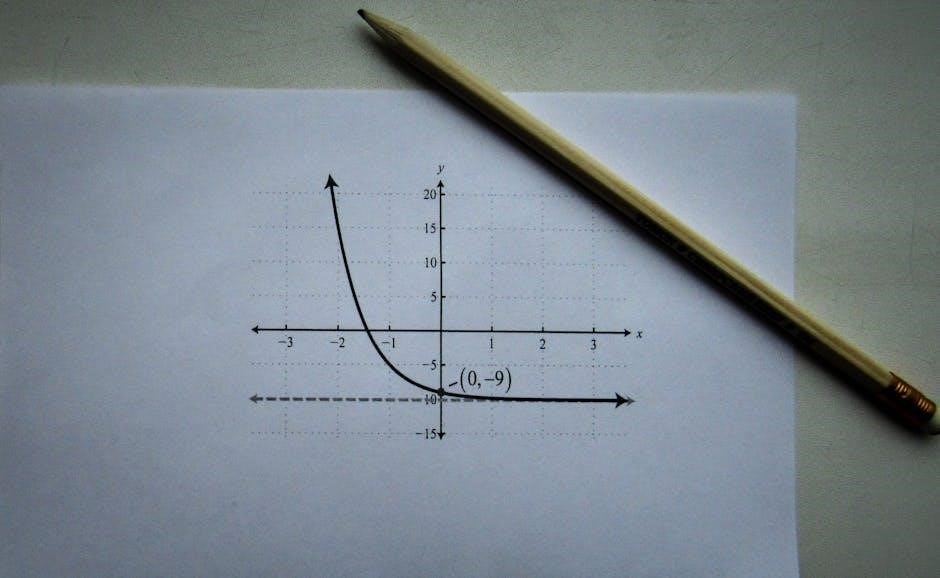A stem-and-leaf plot is a graphical tool that organizes data by splitting numbers into stems and leaves, making it easy to analyze distributions and trends visually. Widely used in education, these plots help students understand data representation effectively.
1.1 Definition and Purpose
A stem-and-leaf plot is a visualization tool that breaks down numerical data into “stems” and “leaves,” where stems represent the higher place values and leaves show the lower ones. This method organizes data cleanly, making it easier to interpret distributions, trends, and key statistics. Its primary purpose is to display data in a way that highlights patterns and outliers while maintaining the original data’s integrity. Often used in education, stem-and-leaf plots help students grasp data analysis concepts visually. They are particularly useful for identifying central tendencies and variability in datasets, making them a valuable resource for both learning and practical applications.
1.2 Importance in Data Analysis
Stem-and-leaf plots are essential in data analysis for their ability to visually represent datasets, making it easier to identify trends, outliers, and key statistics like mean, median, and mode. They provide a clear, organized view of data distribution, helping analysts understand patterns and variability. Unlike bar graphs or histograms, stem-and-leaf plots retain the original data’s precision, allowing for detailed insights. Their simplicity makes them an invaluable tool for educational purposes, enabling students to grasp complex data concepts. By simplifying data interpretation, stem-and-leaf plots foster a deeper understanding of statistics and are widely used in both academic and professional settings for effective data communication.

How to Create a Stem-and-Leaf Plot
To create a stem-and-leaf plot, list the data, separate each number into stem and leaf, organize by stem, and format the plot. This visual tool effectively displays data distribution and trends, making it easy to interpret patterns and statistics.
2.1 Step-by-Step Guide
To create a stem-and-leaf plot, start by listing all data points and identifying the stems and leaves. Organize the data by sorting the stems in ascending order. Next, write each stem on the left side of the plot, followed by its corresponding leaves. Ensure the leaves are ordered and separated by spaces or lines for clarity. Finally, add a key to explain the stem and leaf representation. This method provides a clear visual representation of the data, making it easier to identify trends, modes, and other statistical measures. Proper formatting enhances readability and analysis.
2.2 Organizing Data into Stems and Leaves
Organizing data into stems and leaves involves splitting each number into two parts: the stem (the leading digit(s)) and the leaf (the trailing digit). For example, in the number 42, “4” is the stem, and “2” is the leaf. Sort the data in ascending order and group numbers with the same stem together. Place stems vertically on the left and leaves horizontally next to them. Ensure leaves are ordered and separated for clarity. This structure allows for easy identification of patterns, trends, and key statistical measures like mode and median. Proper organization enhances the plot’s readability and analytical value;
2.3 Formatting the Plot
Formatting a stem-and-leaf plot requires attention to detail for clarity. Ensure stems are listed vertically on the left, with corresponding leaves aligned horizontally. Use consistent spacing between stems and leaves to maintain readability. Include a clear heading and label the axes appropriately. For example, label stems as “Tens” and leaves as “Ones.” Avoid overlapping leaves and ensure they are sorted in ascending order. Use a key or legend if necessary to explain the plot’s structure. Proper formatting makes the plot visually appealing and easier to interpret, enhancing its effectiveness in data analysis and presentation.

Interpreting Stem-and-Leaf Plots
Stem-and-leaf plots visually display data distribution, making it easy to identify patterns, trends, and key statistics like mean, median, mode, and range for accurate data analysis and interpretation.
3.1 Understanding the Distribution of Data
A stem-and-leaf plot provides a clear visual representation of data distribution, showing how values are concentrated or spread across a range. By examining the stems and leaves, one can identify clusters, gaps, and outliers. This tool is particularly effective for understanding central tendency, such as the median and mode, as well as variability like range. The ordered structure allows for easy comparison of data points, making it simpler to analyze trends and patterns within the dataset. This visualization is essential for gaining insights into the overall shape of the data distribution.
3.2 Identifying Key Statistics (Mean, Median, Mode, Range)
Stem-and-leaf plots simplify the identification of key statistics. The median is the middle value when data is ordered, while the mode is the most frequent value. The range is the difference between the largest and smallest values. To calculate the mean, sum all values and divide by their count. These statistics provide insights into data central tendency and variability. By analyzing the stems and leaves, one can quickly locate these measures, making stem-and-leaf plots a valuable tool for statistical analysis and data interpretation in educational settings.
3.3 Analyzing Trends and Patterns
Stem-and-leaf plots effectively reveal trends and patterns by visually organizing data. The vertical arrangement of stems and leaves allows easy identification of data concentrations, shifts, or anomalies over time or across categories. For instance, clusters of leaves on certain stems may indicate peak values, while sparse areas highlight gaps. Trends, such as increasing or decreasing values, are apparent through the plot’s structure. This clarity makes stem-and-leaf plots invaluable for educational purposes, enabling students to interpret and analyze data trends intuitively. Such insights are crucial for understanding distributions and relationships within datasets.

Worksheets with Answers

Stem-and-leaf plot worksheets with answers provide structured practice, featuring customizable datasets and clear solutions. Ideal for educational use, these PDF resources enhance skill mastery and data interpretation.
4.1 Features of Effective Worksheets
Effective stem-and-leaf plot worksheets include clear instructions, varied datasets, and answer keys. They often feature multiple exercises, customizable number sets, and options for PDF formatting. These tools cater to different grade levels, ensuring relevance and challenge. Interactive elements like “make and interpret” sections enhance understanding. Organized layouts and concise solutions support learning, making them ideal for classrooms or independent study. Additionally, they cover advanced topics like back-to-back plots, rounding, and truncating data, providing comprehensive skill development.
4.2 Sample Worksheets for Practice
Sample worksheets for stem-and-leaf plots provide hands-on practice with real-world data. They include exercises like creating plots from datasets, interpreting trends, and calculating statistics such as mode, median, and range. Worksheets often feature scenarios like ages, test scores, or temperatures, making learning relatable. Some include back-to-back plots for comparing groups. Answer keys are provided for self-assessment. These resources are designed to cater to different skill levels, ensuring students grasp both basic and advanced concepts effectively. Regular practice with these worksheets enhances data analysis skills and confidence.
4.3 Answer Keys and Solutions
Answer keys and solutions accompany each worksheet, providing correct stem-and-leaf plots and detailed explanations. They ensure students can verify their work and understand errors. The keys include fully solved plots, calculations for statistics like mean and median, and interpretations of trends. Available in downloadable PDF formats, they offer a quick reference for self-assessment. These resources help students master data analysis skills by comparing their results with the correct answers. Solutions also explain complex steps, fostering a deeper understanding and improving accuracy in creating and interpreting plots. This feature makes worksheets ideal for independent study and skill reinforcement.

Advanced Topics in Stem-and-Leaf Plots
Exploring advanced methods like two-sided, back-to-back plots, and handling rounded or truncated data enhances analytical depth in stem-and-leaf plot interpretations.
5.1 Two-Sided Stem-and-Leaf Plots
A two-sided stem-and-leaf plot displays two datasets side by side, allowing direct comparison. It aids in identifying differences in distribution, medians, and modes between groups effectively.
5.2 Rounding and Truncating Data
Rounding and truncating data are essential steps in creating stem-and-leaf plots, ensuring clarity and precision. Rounding involves approximating data to a specific decimal place, while truncating removes decimal parts entirely. These techniques help in organizing data into manageable stems and leaves, making the plot easier to interpret. For example, truncating 123.45 to 123 simplifies the value for plotting. Proper handling of rounding and truncating maintains data accuracy while enabling effective visualization and analysis.
Worksheets often include exercises on rounding and truncating data, helping students master these skills through practice. This ensures data is represented clearly in stem-and-leaf plots, facilitating better understanding of distributions and trends.
5.3 Back-to-Back Stem-and-Leaf Plots
Back-to-back stem-and-leaf plots are a specialized version used to compare two datasets side by side. Each dataset shares the same stem, with leaves on opposite sides, allowing direct visual comparison. This method is particularly useful for analyzing differences in distribution, central tendency, and variability between groups. For instance, comparing test scores of two classes or heights of two groups. Worksheets often feature exercises where students create and interpret these plots, enhancing their analytical skills. Answer keys provide guidance, ensuring accuracy in identifying modes, medians, and ranges from the plotted data.

Educational Applications
Stem-and-leaf plots are widely used in education to teach data analysis. Worksheets with answers help students master plotting skills, while interactive exercises enhance understanding of data distribution and trends.
6.1 Grade-Specific Worksheets (Grade 4-8)
Grade-specific worksheets for stem-and-leaf plots are tailored to meet the learning needs of students from Grade 4 to Grade 8. These worksheets introduce foundational concepts in data analysis, starting with basic plotting skills for younger students and progressing to more complex tasks like calculating medians and modes. They include exercises that align with curriculum standards, ensuring students develop essential skills in data interpretation. Interactive and printable PDF versions make learning accessible and engaging. Additionally, these worksheets support peer tutoring and study groups, fostering collaborative learning and skill mastery across different grade levels.
6.2 Using Worksheets for Skill Mastery
Worksheets are essential tools for achieving mastery in stem-and-leaf plots, offering structured practice to reinforce learning. By repeatedly creating and interpreting plots, students build proficiency in organizing and analyzing data. Worksheets often include problem sets that incrementally increase in difficulty, allowing learners to apply their skills to various scenarios. Answer keys provide immediate feedback, enabling self-assessment and correction of mistakes. Regular use of worksheets helps students confidently grasp key concepts, such as identifying medians, modes, and ranges, while fostering a deeper understanding of data visualization and interpretation. This hands-on approach ensures long-term retention and skill improvement.
6.3 Role in Peer Tutoring and Study Groups
Stem-and-leaf plot worksheets play a vital role in peer tutoring and study groups by fostering collaborative learning. Students can work together to create and interpret plots, discussing concepts and clarifying doubts. Worksheets provide a structured format for group activities, enabling members to explain their reasoning and learn from one another. Answer keys allow groups to verify their work collectively, promoting teamwork and understanding. These resources also help identify individual strengths and weaknesses, enabling focused practice and reinforcement of skills within a supportive environment. This collaborative approach enhances retention and builds confidence in data analysis and visualization techniques.

Customizing Worksheets
Customizing worksheets allows educators to create tailored stem-and-leaf plots with unique number sets, multiple data sets, and PDF versions, ensuring personalized learning experiences for students.
7.1 Creating Unique Number Sets
Creating unique number sets for stem-and-leaf plot worksheets allows educators to tailor data to specific learning needs. Teachers can design customized worksheets with up to 8 distinct number sets per page, ensuring varied practice. This feature helps students grasp concepts through diverse examples. The ability to generate unique data sets enhances skill mastery and keeps exercises engaging. Additionally, customization options enable educators to adjust data range and complexity, catering to different grade levels or skill proficiency. This flexibility makes worksheets adaptable for individualized instruction or group activities, fostering a deeper understanding of data analysis and interpretation. Unique number sets promote active learning and skill retention effectively.
7.2 Including Multiple Data Sets
Including multiple data sets in stem-and-leaf plot worksheets enhances learning by allowing students to compare and analyze different groups of information. This feature enables educators to create comprehensive exercises where students can practice constructing and interpreting plots for various scenarios. Worksheets often include up to 8 unique number sets, providing diverse practice opportunities. Multiple data sets also help students understand how to identify patterns, trends, and variations across different data groups. This approach fosters a deeper understanding of data distribution and statistical concepts. Additionally, it encourages critical thinking and skill mastery through varied and engaging exercises tailored to different learning needs.
7.3 Generating PDF Versions
Generating PDF versions of stem-and-leaf plot worksheets offers a convenient and professional way to share or print exercises. These PDFs are often customized to include unique number sets and matching answer keys, ensuring consistency and clarity. The PDF format allows for easy distribution among students, whether for classroom use, homework, or study groups. Many worksheets are designed to fit standard paper sizes, such as US Letter or A4, making them practical for printing. This feature is particularly useful for educators seeking to create structured, visually appealing resources that cater to diverse learning needs while maintaining a professional presentation.

Common Questions and Answers
Common questions include how to display specific data values, the impact of new data on the plot, and interpreting modes and medians effectively.

8.1 How to Display Specific Data Values
To display specific data values in a stem-and-leaf plot, each number is split into a stem (the leading digit(s)) and a leaf (the trailing digit). For example, the value 123 is shown as 12|3, where “12” is the stem and “3” is the leaf. This method ensures clarity and organization. When plotting, arrange stems in ascending order and align leaves in a row beside their corresponding stems. For larger datasets, special symbols or keys may be used to represent values like 0|5 (indicating 5). This approach makes data visualization straightforward and interpretable.
8.2 Impact of New Data on the Plot
Adding new data to a stem-and-leaf plot can alter its structure and key statistics. For instance, if a new value like 38 is added, it may extend the range or shift the median. The plot must be reorganized to accommodate the new data, ensuring stems and leaves remain ordered. This adjustment helps maintain clarity and accuracy. For example, adding a value like 123 requires updating the stem-and-leaf format to 12|3, ensuring proper placement. Such updates allow the plot to reflect the updated dataset accurately, preserving its effectiveness in data visualization and analysis.
8.3 Interpreting Modes and Medians
Interpreting modes and medians in stem-and-leaf plots involves identifying key trends. The mode is the most frequently occurring leaf value, while the median is the middle value when data is ordered. To find the median, count the total data points and locate the middle position in the plot. For example, in a plot with 13 data points, the 7th value is the median. Modes are easily spotted by identifying the leaf with the highest frequency. These interpretations help users understand central tendencies and data distribution effectively, making stem-and-leaf plots a valuable tool for quick analysis and insights.
Stem-and-leaf plots are effective tools for understanding data. They enhance learning, offering clear insights into distributions and trends. Regular practice with worksheets ensures mastery in data analysis.
9.1 Summary of Key Concepts
Stem-and-leaf plots are powerful tools for visualizing data distributions. They divide numbers into stems and leaves, enabling clear identification of trends, modes, medians, and ranges. These plots are essential for understanding data organization and interpretation. Worksheets with answers provide structured practice, helping students master data analysis skills. They are particularly valuable for grades 4-8, fostering math proficiency. Regular use of these resources enhances understanding of statistical concepts and prepares learners for advanced data interpretation. The combination of hands-on practice and immediate feedback ensures effective learning and skill development in a structured manner.
9.2 Benefits of Using Stem-and-Leaf Plots
Stem-and-leaf plots offer an accessible way to visualize and interpret data, making complex statistics understandable for learners. They provide a clear structure for identifying patterns, trends, and key statistical measures like mode and median. Worksheets with answers enhance learning by offering hands-on practice, helping students grasp data analysis concepts. These resources also enable immediate feedback, allowing learners to correct mistakes and improve their skills. Additionally, stem-and-leaf plots foster collaborative learning, as students can work together on worksheets and discuss solutions, making them a valuable tool for both individual and group study environments. Their simplicity and effectiveness make them indispensable in education.
9.3 Encouragement for Further Practice
Consistent practice with stem-and-leaf plots is essential for mastering data analysis skills. Worksheets with answers provide learners with the tools to refine their understanding and apply concepts confidently. Encourage students to explore various data sets and interpret results regularly. Utilizing PDF resources and interactive tools can make practice engaging and accessible. By dedicating time to stem-and-leaf plot exercises, learners can develop a stronger grasp of statistical concepts and improve their problem-solving abilities. Regular practice fosters a deeper understanding and prepares students for more advanced analytical tasks in the future.